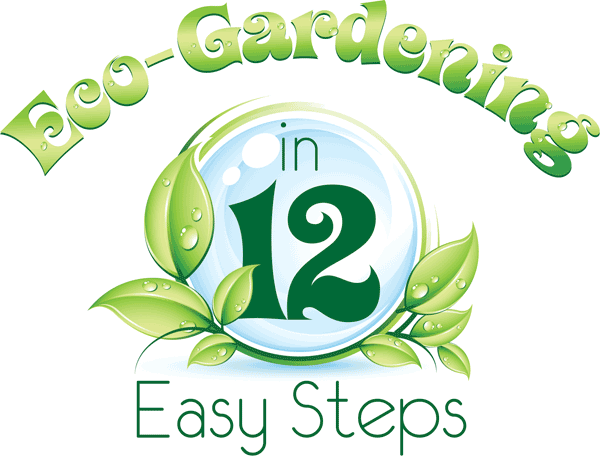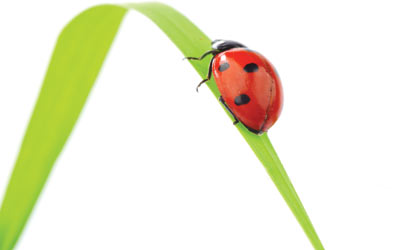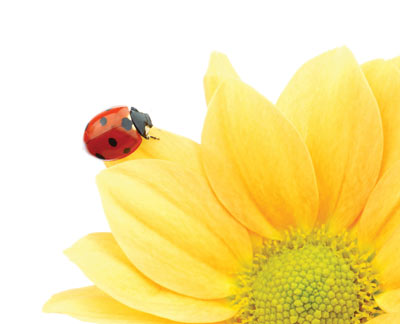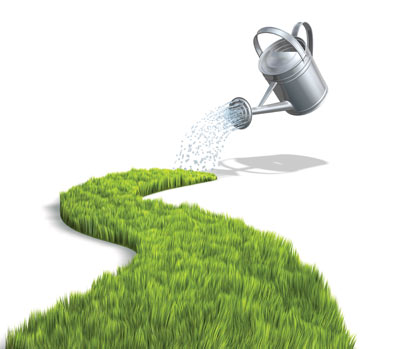
Charles Fedunak is an environmental horticulture agent with the University of Florida’s Lake County Extension Service. His job is to educate the public on environmental issues, including proper gardening techniques. “We each don’t have a lawn or a shrub,” Fedunak says. “We each have our own ecosystem. What we do affects our neighbors and the environment.” As many Americans begin to shift their lifestyles to include organic food, natural cleaners, and a generally chemical-free environment, Fedunak encourages residents to think of their outdoor living spaces as well. He stresses that Central Floridians can still have beautiful outdoor spaces while making less of an environmental impact. Consider the following tips before your next visit to the garden center:

1 Plan Ahead
According to Fedunak, one of the worst things people can do is buy a plant because they think it looks pretty at the garden center. “Think of it as buying golf clubs,” he says. “You wouldn’t just buy any old set because they look nice. You’d know which ones will work best for you and your game.”
2 Right Plant, Right Place
Fedunak stresses choosing plants that will flower and be fragrant, but that will also grow well in the desired location. “Homeowners should take into account soil types, favorable growing conditions for the plant—such as shade- or sun-loving—and how much maintenance the plant or flower will require,” he says. “Purchasing a plant that’s low-maintenance allows the plant to blossom at its own pace.”
 3 Make Two Lists
3 Make Two Lists
The first list should include everything you want in a plant, down to small details. Fedunak says to consider the size of the plant, its flowering capabilities, whether it’s fragrant, whether it will provide food for birds or butterflies, etc. The second list should include the conditions you’re putting it into, including the soil pH, shade and sun conditions, and moisture conditions. Then, with lists in hand, compare each plant. Make sure you choose plants that will do well in your yard. “Anyone can find out their soil pH level for just a few dollars by contacting the extension service,” Fedunak says.
4 Don’t Just Consider The Cold
According to Fedunak, people often look at the cold hardiness of the plant and overlook whether it’s heat/drought tolerant. “We will, without a doubt, have a hot summer,” he says. “We may or may not get a bad winter.”
5 Make Friends With The Bugs
Fedunak points out that not all bugs are bad. “You have to properly identify the insects you see in your garden,” he says. “Some are actually beneficial to the plants and eat the ones that cause all the problems. Before you reach for the pesticides, do a little research.”
 6 Take A Class
6 Take A Class
The extension service offers a variety of gardening classes for area residents. “We offer whole classes on how to select proper plants,” Fedunak says. “We also do one on scouting plants. This means determining what is and isn’t normal for a specific variety, including bugs, fertilizer, fungus, and more.”
7 Spot-Treat For Pests
Fedunak says that if you do come across pests that are unwanted in your garden, spot-treat for them rather than spray the whole landscape.
8 Know Your Fertilizer
The extension service promotes controlled-release fertilizer, if you choose to use one at all. “As a population, we over-fertilize,” Fedunak says. “Commercial growers use a lot because they need their plants to grow quickly. Homeowners, on the other hand, do not. Take into consideration that excessive or rapid growth in plants is more prone to fungus and insect problems. Don’t forget that Mother Nature doesn’t go around throwing fertilizers.”
 9 Don’t Waste Water
9 Don’t Waste Water
Many areas of Central Florida are under water restrictions. Make sure you know your area’s watering regulations, and water appropriately. That said, Fedunak points out that once a plant is established, the watering needs diminish greatly. “I have plants and trees in my yard that haven’t been watered by me in 15 years,” he says. “When arranging your gardens, group your plants according to their watering needs. This way, you only have to water small areas rather than the whole landscape.” You’ll save water and money.
10 Know Your Nutrients
When purchasing fertilizers, all are labeled with three numbers separated by dashes (example: 0-0-0). Fedunak points out that these numbers are the percentage of nutrients in the bag. “Nitrogen, phosphorus, and potassium,” he says. “The percentages are always shown in that order. Don’t forget to read the label further, looking for blends that are slow-release. Remember that with fertilizing, less is always best.” Fedunak adds that if needed, you can always add more fertilizer. But if you put too much down, it’s hard to take it back.
11 Diversify
Fedunak says that many people call the extension service wanting a list of plants that do well in the area. “If we plant too much of one thing, we can create problems with insects,” he says. “I would check what your neighbor has and then do some research and try to do something different.”
12 Keep It In Your Yard
Over-fertilizing and leaving grass clippings in the street creates a run-off problem for not only your neighbors but also the area’s water supply. “Many people live close together,” Fedunak says. “We have to respect our neighbor’s property and space by preventing potentially dangerous runoff.”






